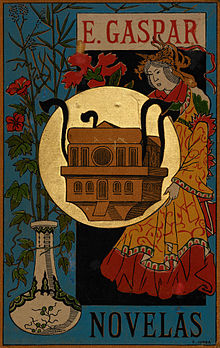El Anacronópete
El Anacronópete is a science fiction novel by the Spanish author Enrique Gaspar y Rimbau published in Barcelona in 1887 and is his best-known work today; it described a time travel using a time machine a year before the publication of the short story The Chronic Argonauts by HG Wells . The novel itself is reminiscent of a Zarzuela , a Spanish comedy full of unexpected twists and turns and rather folk characters. Gaspar y Rimbau wrote the novel while serving as an envoy for the Spanish government in China.
action
In Paris in 1878, Don Sindulfo García, an inventor from Zaragoza, and his assistant Benjamin, a young scholar with a profound knowledge of language and history, presented his invention to the crowd and scholars. The crowd is enthusiastic about the huge time machine, the anacronópete; Don Sindulfo promises to clarify some of the scholars' burning questions about the battle of Tetuan in 1860 on the maiden voyage. Since a rejuvenation effect can also be noticed on the journey into the past, if one has not been impregnated with the inventor's García gas against the effects of time, he also accepts some aging women of "dubious morals" at the request of the Mayor of Paris Board to rejuvenate this; the mayor wants to give them back their youth so that they can become upright wives and mothers.
Don Sindulfo has basically a similar aim; after his first wife, the mute Mamerta, drowned, despite his age, he was strongly drawn to his ward Clarita; but when he announced his intention to marry her, she refused, saying that she had already given her heart to his relative, the hussar captain Luis. The general opinion and legal position is against Don Sindulfo; accordingly he would like to put himself and his ward in "better" times, in which the word of a guardian was still law.
Then the expedition sets off into the past; after the first stop in Tetuan in 1860 it becomes clear that Clarita's fiancé has hidden with some of his soldiers on board; Don Sindulfo lets these, since they are not protected by his García gas, become unborn by a journey into the deeper past, whereupon he falls into a severe depression or madness. Benjamin brings the now time fixated society ladies back into the present and then starts to the second destination, ancient China, in which he hopes to find the key to immortality and Don Sindulfo to find suitable circumstances to break the stubbornness of the beautiful Clarita. On the way they make various stops, including in Granada in 1492, where they advise Queen Isabella to accept a certain Columbus' suggestions.
When they arrived in Ho-nan in China in the year 220, they were drawn into power struggles at the court of Emperor Hien-ti; But the hussars under Luis, whose immortal souls returned to being when the society ladies were transported back and fixed on time, can see the situation and also the empress who was actually murdered by the emperor, who turns out to be an earlier incarnation of the soul of Don Sindulfo's wife, Marmita, save. Something similar happens in Pompeii, where time travelers were supposed to die shortly before the eruption of Vesuvius in 79 to amuse the people in the arena. Benjamín gives his search for the secret of immortality and travels back to the time of the Flood; but the meanwhile completely crazy Don Sindulfo, who now basically sees himself being remarried and deprived of any hope of domestic happiness with Clarita, accelerates the time machine further so that it all crashes to pieces on the day of creation.
Don Sindulfo wakes up shortly before the service; he had fallen asleep in a theater during a performance of Jules Verne's latest play, which he had attended with the newlywed couple Luis and Clarita.
